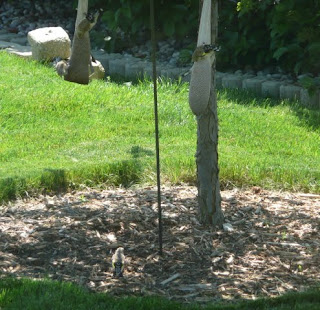This data can give us a wealth of information on the pace and route of migration, and wintering areas. You can read all about how they are used on the RRBO web site.
There is a catch (pun fully intended). In order to get the data, the bird must survive a full migration, return to the original banding location the next year, and be recaptured so the geolocator can be removed and the data downloaded. Last fall, we placed a colored leg band on each of the catbirds which also carried a geolocator, so we could more easily re-find any birds that returned this year.
Well, I couldn't have been happier to find one of our color-banded catbirds singing right behind the Environmental Interpretive Center (EIC). Once I was sure he was going to stay put, I set up three nets between two of his favorite singing perches. While I was setting the nets up, I caught a catbird I presumed might be his mate. It was banded, and turned out to be a bird we banded as a hatching-year bird in August 2008.
 |
| Nets set up on either side of the driveway to the rear of the Environmental Interpretive Center. Hard to see? Good! |
 |
| Vulgaris the Starling Dummy. iPod playing a catbird song in the background. |
 |
| Dana and Darrin, dejected. We thought we were in for a long morning. |
 | ||
| Joy! |
 |
| Three happy catbird catchers, and the subject ready to be released. |
 |
| The well-traveled geolocator. |
Dr. Bowlin is out of state on another field study, and when she returns she will download the data from the device. Then, it will take some additional time to analyze. Sometimes due to weather or time spent in shaded spots by the birds, the data may difficult to interpret. Hopefully, we'll get good data from this bird, as well as any other catbirds that return that we recapture.
And we have already located the favorite singing perch of another color-banded catbird. I hate to report that we have tried catching this bird for several days and have come pretty close, but so far he seems to be on to us and prefers singing about 10 yards from the nets. We also have a tentative sighting of a third bird, and have some areas left to survey for catbird pairs. I'm optimistic we will be able to retrieve a few more geolocators this season.
About half of our catbirds were sponsored by donors last fall. Unfortunately #929 did not have a sponsor, so we didn't get to provide fun news to one of our supporters. If you are interested in sponsoring a catbird with a geolocator, I'll assign one to anybody making a gift of $300 or greater.



















